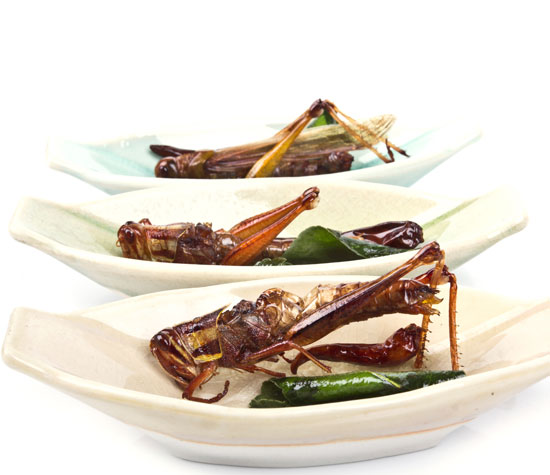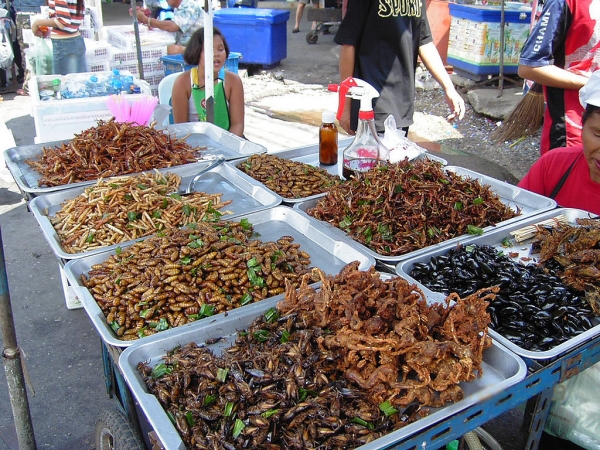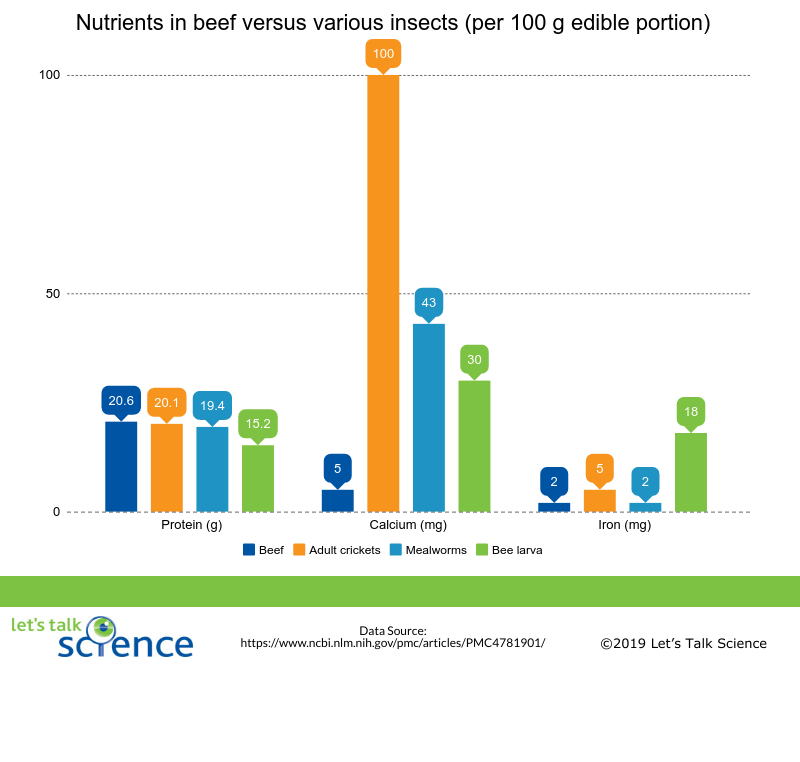Should We Eat Bugs?

Crispy fried crickets (phuketisland, iStockphoto)

Crispy fried crickets (phuketisland, iStockphoto)
How does this align with my curriculum?
| Grade | Course | Topic |
|---|
What's tasty, abundant and high in protein and vitamins? Bugs! Bugs feed about 2 billion people each day. They also hold promise for food security and sustainability.
The roasted crickets were tasty. But the feeling of tiny legs on my tongue was a bit weird. The roasted mealworms much more palatable. That’s probably because they didn’t have legs.
This was my brief foray into entomophagy, otherwise known as eating insects. It happened several years ago at Science North in Sudbury, Ontario. There, staff were offering samples of seasoned crispy bugs to curious visitors.
How about you? Would you ever snack on an insect?
Did you know?
“Bug” is not a scientific term. When people use the word “bugs” they may be talking about insects, arachnids or other invertebrates.
In many parts of the world, your answer might be, “Ick!” For most North Americans, insects are something to eat on a dare. Or they might be a novelty food to try when you’re traveling. But in even more parts of the world, your answer might be, “Of course!” Two billion people around the world include insects in their regular diet.
People have been eating insects for centuries. But in some parts of the world, opinions about insects as food have changed over time. That’s because, around 10 000 BCE, people began farming crops and livestock. Around that time, people probably started to think of insects as pests that could destroy their food, rather than as food itself.
Scientists and sustainable food advocates are hoping to change this. Insects are an environmentally responsible and nutritious food… tiny legs and all.
Who eats insects?
Around 1900 different insect species are eaten. In many places, people don’t eat these insects out of necessity. Instead, they eat them because they taste good! The most popular edible insects are:
- Beetles
- Caterpillars
- Bees
- Ants
- Grasshoppers
- Crickets
Entomophagy is most common in tropical climates. That is probably because the insects there are larger and tend to swarm. This makes them easier to gather.
Also, warmer regions normally have a wider variety of insect species that are available year-round. In colder countries like Canada, many insect species hibernate, so they are not as readily available.
Did you know?
Even if you don’t practice entomophagy (eating insects), you unintentionally eat insect parts every day. For example, the Canadian Food Inspection Agency allows up to 25 insect fragments per 100 grams of rice.
Why farm insects?
Most edible insects are harvested from the wild rather than farmed. But there are compelling reasons to turn our six-legged friends (or their larvae!) into livestock.
The world’s population is expected to reach 9 billion by 2050. The Food and Agriculture Organization (FAO) of the United Nations predicts that the current level of global food production will need to double to feed the mid-twenty-first century world. A big challenge will be providing enough protein for all of those people.

Demand for animal protein is growing worldwide. But raising enough cattle, pigs and chickens to meet this demand is not environmentally sustainable. Raising these livestock requires a lot of land and water, both for the animals themselves and to grow the crops they eat. Clearing land for livestock often requires deforestation, which destroys native plant and animal habitats.
Insects are much more environmentally friendly than traditional livestock. Let’s compare crickets to cows. Crickets use much less land. It takes 400 square metres of land to get one kilogram of beef, but only 30 square metres of land to get one kilogram of crickets. Crickets also use much less water. It takes 2 200 litres of water to get 100 g of beef, and about 2000 times less to get 100 g of crickets.
What’s more, cattle emit huge amounts of a greenhouse gas called methane into the air, in the form of methane-tained gas. This contributes to climate change. Insects produce much less greenhouse gas than our farty four-legged friends. Cockroaches, termites, and scarab beetles are the only insect species that have the kind of bacteria in their guts that make methane. All other insects, including the mealworms and crickets I sampled, have methane-free flatulence.
Methane also comes from the manure (waste) that cattle produce. But according to the FAO, insects might be able to help here, too! Some types of insects will feed off the manure. These insects could, in turn, be used to feed chickens, fish, and other animals farmed for food. Insects could also feed on organic waste products such as vegetable peels.
Did you know?
Dried, ground cochineal insects are the source of a natural red food colouring called carmine, cochineal extract, or natural red 4.
Are insects nutritious?
Eating insects may be good for the environment, but are they good for you? The nutritional profile of insects depends on the species and the stage of life. But in general, insects are high in good quality protein. They are also loaded with many vitamins and minerals such as calcium, zinc, and iron. Most insects are nutritionally similar to beef, pork, or chicken. In fact, many insects pack a better protein punch and deliver more iron.

Graph - Text Version
Per 100 g edible portion; beef has 20.6 g of protein, 5 mg of Calcium and 2 mg of iron; adult crickets have 20.1 g of protein, 100 mg of calcium and 5 mg of iron; meal worms have 19.4 g of protein, 43 mg of calcium and 2 mg of iron and bee larva have 15.2 g of protein, 30 mg of calcium and 18 mg of iron.
What is the future of entomophagy?
Policy makers around the world are investigating insects as a solution to food security. Many people in the world are food insecure. The United Nations estimates that 1 in 9 people suffer from chronic (constant) hunger. And as you have learned, insects could provide a way to feed more people in a sustainable way.
So now that you’ve learned all of this, would you eat bugs as a snack? If you are ready to dive into entomophagy and are looking for some homegrown bugs, Entomo Farms in Campbellford, Ontario can hook you up with seasoned roasted crickets and mealworms (darkling beetle larvae). The owners started their business raising insects for reptile feed. But they saw an opportunity to provide nutritious, environmentally sustainable insect products for people as well. If whole bugs aren’t whetting your appetite, you can start with adding cricket or mealworm flour to your next batch of cookies -- without the legs! Some producers in Quebec are starting to make food out of insects, too. Insect pasta, anyone?
Starting Points
- Did you know that processed foods may contain insect parts? How does that make you feel about the food you eat?
- Would you ever consider eating insects? Why/why not? How has this article and the related videos influenced your opinion about eating insects?
- Would you be more likely to eat an insect if you couldn’t see it in your food? Why/why not?
- Is there a food preparation method (e.g., stir fried, roasted or deep fried, etc.) that would make you more likely to try eating insects? Explain.
- How does insect farming differ from traditional livestock farming in terms of environmental impacts?
- Why is entomophagy a potential solution to global food security issues? Are there places in the world where this solution might work better than others? Explain.
- Society’s view of entomophagy (eating insects) has changed over the years. What technological developments have led to this change?
- Some food manufacturers are able to guarantee their foods do not contain items that people are allergic to (e.g., nuts). Do you think it would be possible for food manufactures to guarantee their food does not contain insect parts? Explain.
- What does the term food security mean?
- How could farming insects help overpopulated areas provide additional food sources? Explain.
- What nutritional supports can insects provide to the human diet?
- Why is farming and consuming insects considered less damaging to the environment than raising cattle for beef?
- How does the media portray insects in a way that makes them undesirable as a food source? Explain. What media have you seen that portrays eating insects (entomophagy) in a positive way?
- There are a lot of animated movies about insects and other bugs - A Bug’s Life (1998), Antz (1998), Bee Movie (2007) and Charlotte's Web (2006), to name a few. Do these movies help or hinder our relationship with bugs? How so? Do these fictional images of bugs make us not want to eat real bugs? Explain.
- This article with embedded videos can be used to support teaching and learning of Health, Biology, Environmental Science, Food & Nutrition, Sustainability, Human effect on ecosystem, Agriculture and practices and Climate Change related to food security, nutrition, sustainability, sustainable living and vitamins. Concepts introduced include entomophagy, pests, methane, climate change, manure, vitamins, iron, hemoglobin, iron deficiency anemia and food security.
- Before watching the video Should We Eat Bugs?, have students complete an Anticipation Guide in order to get them thinking about insects as food. The ready-to-use reproducibles for this learning strategy may be downloaded in [Google doc] and [PDF] formats. The answer key is available as a [PDF].
- While reading the article and viewing the embedded videos, teachers could have students compile, compare and contrast the information in the article with that of the videos by completing a Print-Video Venn Diagram learning strategy. Either of the videos or both could be used. Ready-to-use Print-Video Venn Diagram reproducibles are available for download in [Google doc] and [PDF] formats.
- After watching the video, teachers could lead a discussion on using insects as a food source. Teachers could use a Pros & Cons Organizer to help students organize the information in the video and help the students make a decision about using bugs as a food source. The ready-to-use reproducibles for this learning strategy may be downloaded in [Google doc] and [PDF] formats.
- To go further and expand students’ awareness of insect-based foods, teachers could have students look online or in stores in your community for different insect foods that are available to consumers. For a hands on experience in a Foods and Nutrition class, these foods could be sampled and/or used in a recipe. As with all foods, teachers and students should be aware and cautious of potential food allergies.
Connecting and Relating
- Did you know that processed foods may contain insect parts? How does that make you feel about the food you eat?
- Would you ever consider eating insects? Why/why not? How has this article and the related videos influenced your opinion about eating insects?
- Would you be more likely to eat an insect if you couldn’t see it in your food? Why/why not?
- Is there a food preparation method (e.g., stir fried, roasted or deep fried, etc.) that would make you more likely to try eating insects? Explain.
Relating Science and Technology to Society and the Environment
- How does insect farming differ from traditional livestock farming in terms of environmental impacts?
- Why is entomophagy a potential solution to global food security issues? Are there places in the world where this solution might work better than others? Explain.
- Society’s view of entomophagy (eating insects) has changed over the years. What technological developments have led to this change?
- Some food manufacturers are able to guarantee their foods do not contain items that people are allergic to (e.g., nuts). Do you think it would be possible for food manufactures to guarantee their food does not contain insect parts? Explain.
Exploring Concepts
- What does the term food security mean?
- How could farming insects help overpopulated areas provide additional food sources? Explain.
- What nutritional supports can insects provide to the human diet?
- Why is farming and consuming insects considered less damaging to the environment than raising cattle for beef?
Media Literacy
- How does the media portray insects in a way that makes them undesirable as a food source? Explain. What media have you seen that portrays eating insects (entomophagy) in a positive way?
- There are a lot of animated movies about insects and other bugs - A Bug’s Life (1998), Antz (1998), Bee Movie (2007) and Charlotte's Web (2006), to name a few. Do these movies help or hinder our relationship with bugs? How so? Do these fictional images of bugs make us not want to eat real bugs? Explain.
Teaching Suggestions
- This article with embedded videos can be used to support teaching and learning of Health, Biology, Environmental Science, Food & Nutrition, Sustainability, Human effect on ecosystem, Agriculture and practices and Climate Change related to food security, nutrition, sustainability, sustainable living and vitamins. Concepts introduced include entomophagy, pests, methane, climate change, manure, vitamins, iron, hemoglobin, iron deficiency anemia and food security.
- Before watching the video Should We Eat Bugs?, have students complete an Anticipation Guide in order to get them thinking about insects as food. The ready-to-use reproducibles for this learning strategy may be downloaded in [Google doc] and [PDF] formats. The answer key is available as a [PDF].
- While reading the article and viewing the embedded videos, teachers could have students compile, compare and contrast the information in the article with that of the videos by completing a Print-Video Venn Diagram learning strategy. Either of the videos or both could be used. Ready-to-use Print-Video Venn Diagram reproducibles are available for download in [Google doc] and [PDF] formats.
- After watching the video, teachers could lead a discussion on using insects as a food source. Teachers could use a Pros & Cons Organizer to help students organize the information in the video and help the students make a decision about using bugs as a food source. The ready-to-use reproducibles for this learning strategy may be downloaded in [Google doc] and [PDF] formats.
- To go further and expand students’ awareness of insect-based foods, teachers could have students look online or in stores in your community for different insect foods that are available to consumers. For a hands on experience in a Foods and Nutrition class, these foods could be sampled and/or used in a recipe. As with all foods, teachers and students should be aware and cautious of potential food allergies.
Learn more
Insects for food and feed: Infographics (2014)
Infographics from the Food and Agriculture Organization of the United Nations about edible insect consumption around the world
Family of cricket farmers tries not to take their work home with them (but it’s hard) (2018)
Article from The Star on Entomo Farms and its efforts to market insects as food.
Edible insects: Future prospects for food and feed security (2013)
United Nations website and the full report on the potential of edible insects to help meet the world’s food needs, while supporting economic development and environmental conservation.
Planet of the Insects (2013)
Infographic by Ensia highlighting the large number and diversity of insect species
References
Loeffler, J. (2018, December 23). Should we be wating bugs? Interesting Engineering.
Näak. (n.d.). Why you should eat insects: Cricket vs. beef.
United Nations. (n.d.). Food.